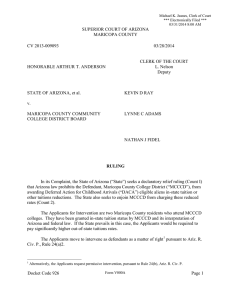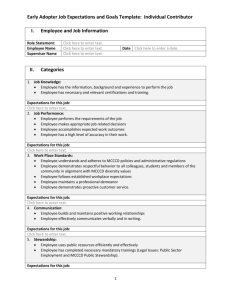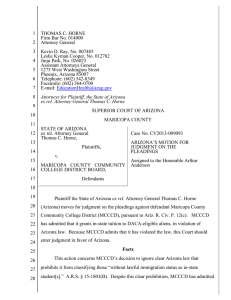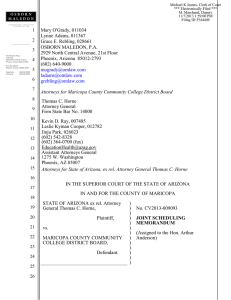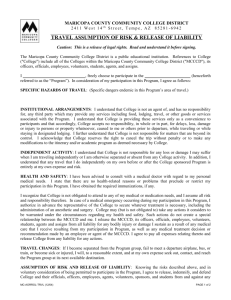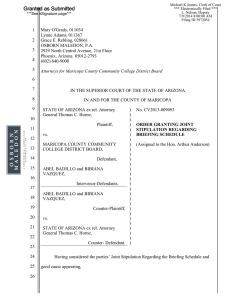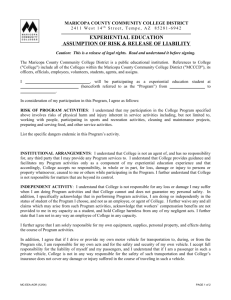1 THOMAS C. HORNE Firm Bar No. 014000
advertisement
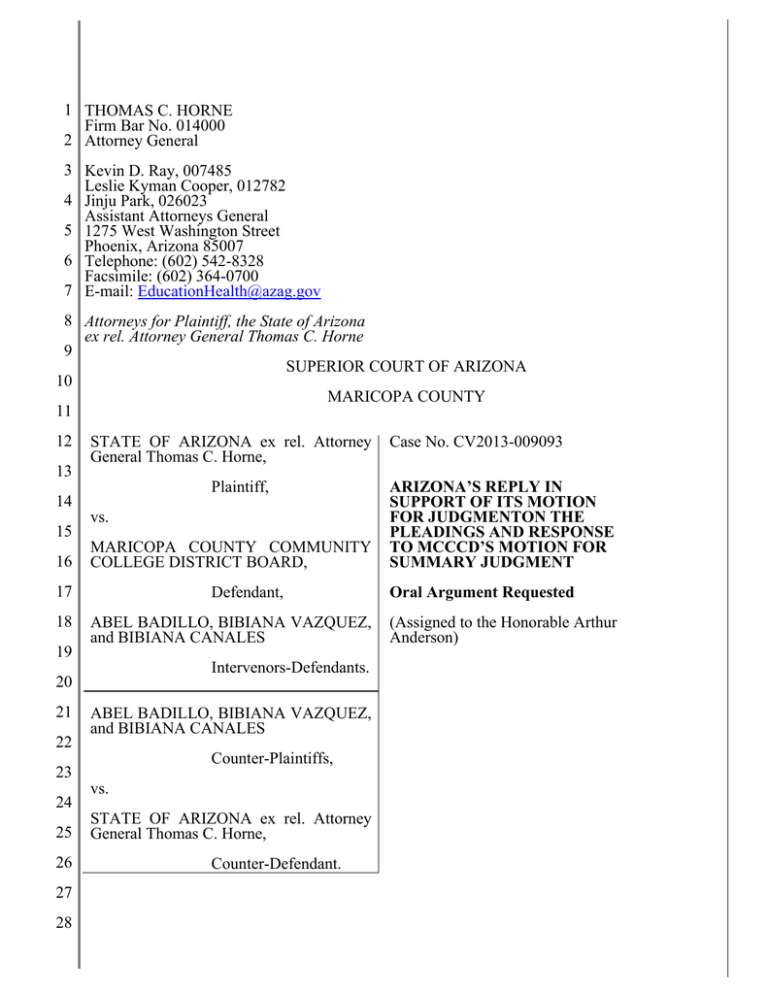
1 THOMAS C. HORNE Firm Bar No. 014000 2 Attorney General 3 Kevin D. Ray, 007485 Leslie Kyman Cooper, 012782 4 Jinju Park, 026023 Assistant Attorneys General 5 1275 West Washington Street Phoenix, Arizona 85007 6 Telephone: (602) 542-8328 Facsimile: (602) 364-0700 7 E-mail: EducationHealth@azag.gov 8 Attorneys for Plaintiff, the State of Arizona ex rel. Attorney General Thomas C. Horne 9 SUPERIOR COURT OF ARIZONA 10 MARICOPA COUNTY 11 12 13 STATE OF ARIZONA ex rel. Attorney General Thomas C. Horne, Plaintiff, 14 15 16 vs. MARICOPA COUNTY COMMUNITY COLLEGE DISTRICT BOARD, 17 18 19 Defendant, ABEL BADILLO, BIBIANA VAZQUEZ, and BIBIANA CANALES Intervenors-Defendants. 20 21 22 ABEL BADILLO, BIBIANA VAZQUEZ, and BIBIANA CANALES Counter-Plaintiffs, 23 24 25 26 27 28 vs. STATE OF ARIZONA ex rel. Attorney General Thomas C. Horne, Counter-Defendant. Case No. CV2013-009093 ARIZONA’S REPLY IN SUPPORT OF ITS MOTION FOR JUDGMENTON THE PLEADINGS AND RESPONSE TO MCCCD’S MOTION FOR SUMMARY JUDGMENT Oral Argument Requested (Assigned to the Honorable Arthur Anderson) 1 Introduction 2 The State of Arizona ex rel. Attorney General Thomas C. Horne hereby makes its reply 3 in support of its Motion for Judgment on the Pleadings and responds to MCCCD’s Motion for 4 Summary Judgment. This case concerns the interpretation of Arizona law. More specifically, it concerns the 5 6 interpretation of two voter-protected statutes: A.R.S. §§ 15-1803 and 1825. These statutes— 7 enacted pursuant to a voter referendum—address the ability of aliens who came to this country 8 unlawfully to qualify for taxpayer-funded benefits.1 More specifically, they prohibit those 9 who are “without lawful status” from being eligible for in-state tuition. These statutes are at 10 issue because of the DACA Memorandum, which describes the decision of the Secretary of the 11 Department of Homeland Security to defer prosecution of certain young people brought here 12 illegally as children. The DACA Memorandum raises this question: what is the effect of the 13 DACA-eligibility on the immigration status of those eligible for the program? Stated 14 otherwise, does eligibility for deferred action make a student eligible for resident tuition? 15 Arizona has concluded that DACA recipients lack lawful immigration status and are therefore 16 not eligible for in-state tuition. MCCCD asserts that beneficiaries of the DACA Memorandum 17 are lawfully present and therefore eligible for in-state tuition. Resolution of this question is a matter of law. There are no facts at issue. MCCCD 18 19 admits all of the relevant facts; it admitted that it grants in-state tuition to DACA-eligible 20 aliens. (MCCCD’s Answer, ¶ 13.) Its Disclosure Statement combines its discussion of facts 21 and law into one section—Factual Basis and Legal Theories of Defenses—and then elaborates 22 upon its legal position. Defendant’s Initial Rule 26.1 Disclosure Statement, at 1 – 7, attached 23 to Arizona’s Responsive Statement of Facts regarding MCCCD’s Claims (“Arizona’s RSOF– 24 25 26 27 28 1 Proposition 300 amended A.R.S. § 15-1803 by adding sections (B) and (C), which prohibit students that lack lawful immigration status from paying in-state tuition and require certain reporting. It added A.R.S. § 15-1825 which contains further limitations on financial assistance to students without lawful status and also requires certain reporting. Because the changes were made pursuant a voter referendum, they are protected by the Voter Protection Act, which “limits the legislature's authority to amend measures approved by voters.” Arizona Early Childhood Dev. and Health Bd. v. Brewer, 221 Ariz. 467, 469, ¶ 6, 212 P.3d 805, 807 (2009) (describing Voter Protection Act, Ariz. Const. art. 4, pt. 1, § 1(C)-(D).) -2- 1 M”) as Exhibit A. The Disclosure Statement describes no factual disputes, but instead states, 2 “At the heart of the dispute between the Attorney General and MCCCD is whether DACA 3 participants may present employment authorization documents as evidence of eligibility for 4 resident tuition.” Id., at 2. Resolution of that question will turn on the meaning and effect of 5 A.R.S. §§ 15-1803 and 1825, and their intersection with 8 U.S.C. §§ 1621 and 1623, the 6 matters addressed by the Disclosure Statement. Not surprisingly, MCCCD listed no witnesses 7 who could dispute the central issue—whether MCCCD can accept employment authorization 8 documents as evidence of eligibility for in-state tuition. 9 MCCCD’s attempt to convert Arizona’s motion for judgment on the pleadings to a 10 motion for summary judgment fails to put any facts in issue. MCCCD begins by 11 acknowledging that “the resolution of this matter hinges on statutory construction.” 12 Defendant’s Motion for Summary Judgment and Response to Arizona’s Motion for Judgment 13 on the Pleadings (“MCCCD’s Response and MSJ”), at 1. Its purported statement of facts 14 simply recites the relevant law and legislative history. It describes “Federal and State 15 Immigration Laws” in paragraphs 1-3 and the DACA program, in paragraphs 4-5. It then 16 presents its legal conclusions as to “DACA Students’ Eligibility for Resident Tuition,” which is 17 the ultimate, and only, issue in this matter. See Statement of Facts in Support of MCCCD’s 18 Motion for Summary Judgment (“MCCCD’s SOF”). 19 I. Eligibility for DACA Does Not Change Beneficiaries’ Immigration Status. 20 MCCCD errs because it equates presence with status, and assumes that lawful presence 21 is the same as lawful status. It compounds the error when it asserts that because DACA 22 recipients are lawfully present for some purposes, they are lawfully present for all purposes. 23 MCCCD Response and MSJ, at 4. Also, it asserts that the Arizona statutes governing 24 eligibility for in-statute tuition, which expressly refer to those “without lawful status” (A.R.S. 25 §§ 15-1803, -1825) in fact mean to refer to those “without lawful presence.” MCCCD then 26 combines its novel, and incorrect, attempt to rewrite the language of A.R.S. §§ 15-1803 and 27 1825, with its overbroad characterization of the effect of DACA, to assert that DACA 28 recipients are here lawfully and are thus eligible for in-state tuition in Arizona. -3- 1 MCCCD proceeds from flawed premises. DACA recipients are not lawfully present in 2 the United States for all purposes; even if they are lawfully present for some purposes, there is 3 no indication that they are lawfully present for all purposes or that they possess lawful 4 immigration status. See Ariz. Dream Act Coal. v. Brewer, No. 13–16248, 2014 WL 3029759 5 (9th Cir. July 7, 2014) (“DACA recipients enjoy no formal immigration status”). Second, 6 Arizona law prevents those without lawful status from paying in-state tuition. A.R.S. §§ 15- 7 1803(B) and 1825. Arizona Revised Statutes §§ 15-1803 and 1825 are part of Proposition 300, 8 a voter referendum enacted in 2006. There is no indication that Arizona voters intended to 9 allow those who came here illegally to receive the benefit of taxpayer-subsidized lower tuition 10 rates. A. 11 12 The Only Benefit DACA-Eligible Students Enjoy is Temporary Relief from Deportation. 13 The DACA Memorandum represents nothing more than an agency’s declaration of its 14 policy regarding the use of scarce prosecutorial resources.2 It represents a decision to not use 15 scarce prosecutorial resources to remove those who were brought here illegally as children and 16 who meet the remaining requirements described in the policy. It does not purport to change an 17 immigrant’s legal status and indeed, it could not. The DACA Proclamation itself recognizes its 18 limitations and reminds DACA beneficiaries that only Congress can change an immigrant’s 19 status, when it says, “This memorandum confers no substantive right, immigration status or 20 pathway to citizenship. Only the Congress, acting through its legislative authority, can confer 21 22 23 24 25 26 27 28 2 Decisions about how to allocate prosecutorial resources, known generally as prosecutorial discretion, are generally part of an enforcing agency’s general authority. Congressional Research Service Memorandum dated July 13, 2012, regarding “Analysis of June 15, 2012 DHS Memorandum, Exercising Prosecutorial Discretion with Respect to Individuals Who Came to the United States as Children,” at 5, 11-17 (describing enforcement agencies’ prosecutorial discretion) (hereinafter, “CRS DACA Memorandum”). (For the Court’s convenience, a copy of this memorandum is attached to Arizona’s RSOF–M as Exhibit B.) A 2000 Immigration and Naturalization Service memorandum explained that the Immigration and Naturalization Service, like all law enforcement agencies, must examine its resources and set its priorities to allow it to achieve its most important goals. See Doris Meissner, Commissioner, Immigration and Naturalization Service, Exercising Prosecutorial Discretion, memorandum to regional directors, district directors, chief patrol agents, and the regional and district counsels, November 7, 2000, attached to Arizona’s RSOF-M as Ex. C. See also MCCCD’s SOF”, at ¶ 4. -4- 1 these rights.” DACA Memorandum, attached as Ex. B to Arizona’s Complaint. These 2 limitations are inherent in both the form of relief—an agency proclamation—and the nature of 3 the relief—a deferral of prosecution. The DACA Memorandum does not represent either a 4 rule, promulgated pursuant to specific statutory authority after notice and comment, or statute, 5 passed by Congress.3 And, a deferral of prosecution is only a statement that the agency will 6 not act regarding a violation of law at that moment. Furthermore, as the United States 7 Citizenship and Immigration Services recently emphasized, DACA status is tenuous and 8 subject to termination at any time with no notice. See USCIS Frequently Asked Questions 9 updated June 5, 2014, attached as Exhibit 9 to MCCCD’s SOF at Q27 (deferred action can be 10 terminated “at any time, with or without a Notice of Intent to Terminate, at DHS’s discretion”). The information that the United States Citizenship and Immigration Service published 11 12 regarding DACA confirms the limited consequences of DACA eligibility. Its Frequently 13 Asked Questions include the following statements: • • 14 15 “[D]eferred action does not confer lawful status upon an individual[.]” “DHS can terminate or renew deferred action at any time, at the agency’s discretion.” “[D]eferred action does not confer a lawful status.” 16 • 17 And, most importantly, 18 Apart from the immigration laws, “lawful presence”, “lawful status” and similar terms are used in various other federal and state laws. For information on how those laws affect individuals who receive a favorable exercise of prosecutorial discretion under DACA, please contact the appropriate federal, state or local authorities.4 19 20 21 22 23 24 25 26 27 28 3 In fact, every effort to date to pass a statute providing this kind of relief to those who arrived here illegally as children has failed. CRS DACA Memorandum, at 2-4. 4 USCIS makes this statement in context of addressing the fact that DACA eligibility means that the recipient does not accrue unlawful presence for admissibility purposes. Here, USCIS is referring to 8 U.S.C. § 1182(a)(9)(B). That statute addresses the admissibility of certain aliens who were not admitted or paroled into the United States or who stayed beyond the expiration of “the period of stay authorized by the Attorney General,” and delays the time that such persons can apply for admittance to the United States, depending on specified circumstances. 8 U.S.C. § 1182(a)(9)(B). Thus, USCIS’s decision that it will not count the time that a person is present in the United States under a grant of deferred prosecution for purposes of accruing unlawful presence as it relates to admissibility is not a decision about the lawfulness of a person’s status for other authorities. -5- 1 Id., Q1, Q5. Thus, not only has DHS clearly stated that the DACA Memorandum does not 2 change a beneficiary’s immigration status, it has clearly stated that other government authority 3 must be considered when determining how “a favorable exercise of prosecution under DACA” 4 affects the recipient.5 In other words, a grant of deferred prosecution pursuant to the DACA 5 memorandum does not necessarily affect an immigrant’s status for other purposes. MCCCD notes DACA recipients receive Social Security numbers and Employment 6 7 Authorization Documents (“EADs”); it asserts that such documents are not available to those 8 who are unlawfully present, and that the ability of DACA recipients to get such documents is 9 further proof that they are lawfully present and thus eligible for in-state tuition. MCCCD 10 Response and MSJ, at 13. This argument is incorrect. The Secretary of Homeland Security 11 possesses the discretion to issue work authorization documents and Social Security numbers to 12 those who are unlawfully present. 8 U.S.C. § 1324a, 1324b, and 1324a(h)(3)(granting 13 Secretary of Homeland Security the authority to issue work authorization to those who are 14 unlawfully present); see CRS DACA Memorandum, at 17-18 (describing wide latitude of 15 Secretary to grant work authorization, including to those not lawfully present). Thus, a work 16 authorization document is not evidence of anything but authorization to work; it does not show 17 or establish lawful presence and does not establish eligibility for public benefits. In fact, 18 deferred action recipients are similar to other “foreign nationals with relief from removal who 19 obtain temporary work authorizations” and who can be characterized as “‘quasi-legal’ 20 unauthorized migrants [who] may be considered ‘lawfully present’ for some very narrow 21 purposes under the INA [Immigration and Nationality Act] (such as whether the time in 22 deferred status counts as illegal presence under the grounds of inadmissibility) but are 23 otherwise unlawfully present.” CRS DACA Memorandum, at 18-19. 24 25 26 27 28 5 Notably, the federal government has chosen to pick and choose as to when it will consider DACA-eligible aliens “lawfully present.” Ariz. Dream Act Coal. v. Brewer, 945 F. Supp. 2d 1045, 1061 (D. Ariz. 2013) (“the Department of Health and Human Services (‘DHHS’) has determined that DACA recipients are not ‘lawfully present’ for purposes of health care benefits conferred on other deferred action recipients, 45 C.F.R. § 152.2(8)”) rev’d on other grounds No. 13–16248, 2014 WL 3029759 (9th Cir. July 7, 2014). -6- 1 There is one other indication that the DACA Memorandum does not establish lawful 2 immigration status: even after being granted deferred action, DACA beneficiaries are not free 3 to leave the country. To leave, they must obtain advance parole. USCIS FAQ, at Q54. And, 4 advance parole allowing travel requires advance permission, obtained, at the discretion of the 5 federal government, after submitting a form and $360. Id. Furthermore, USCIS allows travel 6 only for limited purposes: humanitarian, education and employment. Id. Vacation is not a 7 valid basis for parole. Id. Put simply, DACA-eligible aliens must pay $360 to apply for the 8 privilege of leaving the country, must disclose their reasons for travel, and ensure that they fall 9 within one of three limited categories of travel. They cannot leave the country until they 10 receive permission, and will not know if permission will be granted until it is. See 11 http://www.visanow.com/should-i-apply-for-advance-parole-if-i-have-deferred-action/, (last 12 accessed June 17, 2014.) And, even if advance parole is granted, there is no guarantee that the 13 parolee will be allowed back into the country. See 14 http://www.nilc.org/FAQdeferredactionyouth.html (last accessed June 17, 2014); see also 15 http://www.visanow.com/should-i-apply-for-advance-parole-if-i-have-deferred-action (“DHS 16 can revoke an advance parole document at any time, . . .”) (last accessed June 17, 2014). 17 II. Arizona Law Restricts Unlawful Aliens from Paying In-State Tuition. 18 MCCCD next asserts that A.R.S. §§ 15-1803 and 1825, which state that those “without 19 lawful immigration status” are not eligible for in-state tuition in fact means that those “without 20 lawful presence” are not eligible for in-state tuition, and that conversely, those “with lawful 21 presence” are eligible for such tuition. It concludes its argument by asserting that because 22 DACA recipients are here lawfully, they are eligible for in-state tuition. 23 MCCCD’s conclusion is not supported by the statutory language or legislative history. 24 MCCCD first notes that Arizona statutes, Arizona Attorney General Opinions, and even 25 Arizona’s briefs in this matter, use the terms “lawful presence,” “unlawful presence,” “lawful 26 status” and “unlawful status” interchangeably and without precision. MCCCD then notes, 27 again generally correctly, that the legislative history of Proposition 300 indicates that Arizona 28 taxpayers wanted to prevent those here illegally from being able to pay in-state tuition. -7- 1 MCCCD’s Response and MSJ, at 7-10. Relying on these premises, MCCCD then asserts that 2 DACA recipients are lawfully present and therefore not prohibited by A.R.S. §§ 15-1803 and 3 1825 from paying in-state tuition. 4 This conclusion is incorrect, and in any event, does not follow from the premises. First, 5 this conclusion is valid only if one assumes that if DACA recipients are here lawfully for some 6 purposes, they are here lawfully for all purposes. However, as pointed out above, this 7 assumption is not valid. Second, and again as noted above, eligibility for deferred action under 8 DACA does not change an immigrant’s legal status. Additionally, it is useful to note that at 9 least one other court has concluded that the phrases “an alien who is not lawfully present in the 10 United States” and “a person without lawful immigration status” have the same meaning. See 11 Martinez v. Regents of the Univ. of Cal., 241 P.3d 855, 862 (2010) (using the phrase “unlawful 12 alien” so as to be both “neutral” and “accurate” where the state and federal statutes referred to 13 those “without lawful immigration status” and those “not lawfully present”). 14 Most importantly, MCCCD’s argument depends upon the premise that either the 15 legislators who referred Proposition 300 to the voters or the voters who enacted it would draw a 16 distinction between those who arrived here illegally and remain here illegally, on the one hand, 17 and those who arrived here illegally and were granted relief from removal pursuant to a DHS 18 Policy memorandum, on the other hand. This premise is not supported or supportable. Those 19 favoring Proposition 300 used a variety of terms to describe those who would not be eligible 20 for in-state tuition if Proposition 300 passed, including “illegals,” “those who break the law to 21 enter Arizona illegally,” “those who are not legal residents of Arizona or who are not citizens 22 of the United States,” “illegal aliens,” and “those who have chosen to violate our laws.” See 23 Publicity Pamphlet for Proposition 300 at 4-5, attached as Ex. 5 to MCCCD’s SOF. All of 24 those terms indicate that Arizona voters did not want those aliens who did not enter this 25 country lawfully, such as those who are eligible for deferred action under DACA, to have the 26 benefit of taxpayer-funded benefits such as in-state tuition. There is no indication that Arizona 27 voters would consider aliens who arrived here illegally and who were granted some form of 28 -8- 1 temporary relief from deportation by the federal government to be eligible for such benefits, as 2 a result of such federal action.6 3 III. Federal Law Restricts States from Offering Public Benefits Such as In-state Tuition. 4 Arizona law is consistent with federal law. Federal law restricts the eligibility of many 5 unlawfully present aliens for state and local public benefits, including in-state tuition. Contrary 6 to MCCCD’s representation, the controlling statute is 8 U.S.C. § 1621, which prevents those 7 who are not qualified aliens from access to state and local public benefits, including “any . . . 8 postsecondary education . . . or any other similar benefit for which payments or assistance are 9 provided to an individual . . . by an agency of a State or local government or by appropriated 10 funds of a State or local government.” In-state tuition is a state or local public benefit. 11 Martinez v. Regents of the Univ. of Cal., 166 Cal. Rptr. 3d 518, 531 (2008), rev’d on other 12 grounds, 241 P.3d 855 (2010). See also Kate M. Manuel, Unlawfully Present Aliens, Higher 13 Education, In-state Tuition, and Financial Aid: Legal Analysis, at 7 (Congressional Research 14 Service, July 21, 2014) (“In-state tuition has generally been considered a public benefit, and 15 PRWORA and IIRIRA restrict the circumstances in which states may provide public benefits 16 to unlawfully present aliens.” (For the Court’s convenience, a copy of this report is attached 17 Arizona’s RSOF–M as Exhibit D.) While 8 U.S.C. § 1621 was enacted first, and contains the general prohibition on 18 19 granting in-state tuition to those not here lawfully, 8 U.S.C. §1623 is also applicable. This 20 section, which was enacted as part of the Illegal Immigration Reform and Immigrant 21 Responsibility Act (“IIRIRA”), constitutes a further narrowing of a state’s ability to provide in- 22 state tuition benefits to those not here lawfully. It “prohibits a state from making unlawful 23 aliens eligible ‘on the basis of residence within a State’ for a postsecondary education benefit.” 24 Martinez v. Regents of the University of California, 241 P.3d 855, 863 (2010), quoting 8 U.S.C. 25 26 27 28 6 MCCCD’s argument relies on voters’ having a thorough understanding of the complexities of immigration law, an argument that is not tenable. See Jane S. Schacter, The Pursuit of “Popular Intent”: Interpretive Dilemmas in Direct Democracy, 105 Yale L.J. 107 (1995)(noting that “[v]oters generally lack detailed knowledge of the legal context surrounding a proposed initiative statute” and are “unfamiliar with the technical legal jargon that is used in the text of initiatives”). -9- 1 § 1623(a).7 Thus, while it does, as MCCCD asserts, “specifically address eligibility for in- 2 state tuition,” it does not grant eligibility for in-state tuition, but rather regulates the manner in 3 which a state may offer such eligibility. As MCCCD emphasizes, A.R.S. § 15-1803(B) does state that it was enacted “[i]n 4 5 accordance with the illegal immigration reform and immigrant responsibility act.” MCCCD 6 relies on this to support its argument that the state law that says “without lawful status” must 7 mean “not lawfully present.” First, contrary to MCCCD’s representation, IIRIRA does not 8 grant any benefits; instead, it narrows a state’s ability to grant in-state tuition to certain aliens. 9 Thus, it is not correct to rely on the reference to IIRIRA in A.R.S. § 15-1803 to argue that it 10 somehow makes DACA-recipients eligible for in-state tuition. Second, as noted in Section II 11 above, it’s not clear that the terms “without lawful status” and “not lawfully present” carry the 12 different meanings that MCCCD imputes to them. Third, it is not clear what intent can be 13 ascribed to the specific language of a voter-enacted statute. While Arizona courts do their best 14 to divine voter intent from publicity pamphlets (Ariz. Citizens Clean Elections Comm’n v. 15 Brain, 234 Ariz. 322, 327; 322 P.3d 139, 144 (Ariz. 2014) (reviewing publicity pamphlet as 16 guide to voter intent), at least one commentator has noted the difficulty, and perhaps, futility, of 17 such an effort. Jane S. Schacter, The Pursuit of “Popular Intent”: Interpretative Dilemmas in 18 Direct Democracy, 105 Yale L.J. 107 (1995)(noting that “the notion that voters had any intent 19 at all on the interpretive question facing the court— individually or collectively—is often 20 untenable. That interpretive question is frequently obscure, technical, or one that requires 21 22 23 24 25 26 27 28 7 Martinez rejected a challenge to a California state statute that grants in-state tuition to those persons who meet three requirements: 1) they possess a California high school degree; 2) that if they are unlawful aliens, they affirm that they will try to legalize their status; and 3) they have attended high school in California for three or more years. Several other states have enacted similar statutes that allow grant in-state tuition on a basis other than residence. See e.g. Colo. Rev. Stat. § 23-7-110; N.J. Stat. Ann. 18A:62-4.4; N.M. Stat. Ann. § 21-1-4.6. At one point before referral to the voters, Proposition 300 included provisions that would have allowed those who attended public school in Arizona for six years, graduated from public high school here and whose parent paid income tax here for six preceding taxable years to be classified as an in-state student for tuition purposes. S. Con. Res. 1031, 47th Leg., 2d Reg. Sess. (Ariz. 2006), attached to Arizona’s RSOF-M as Ex. E. - 10 - 1 knowledge of a body of related laws and doctrines. There is no particular reason to believe that 2 voters had anything at all in mind on such questions.”). 3 IV. MCCCD’s Conflict Preemption and Equal Protection Arguments Are Not Supported. 4 5 MCCCD next argues that Arizona law regarding the provision of benefits to aliens must 6 be construed to be consistent with federal law or constitutional concerns, such as preemption or 7 equal protection problems, will be raised. MCCCD Response and Reply, at 10-11. MCCCD’s 8 argument about preemption does not make sense. First, MCCCD’s statement that “[s]tate law 9 that conflicts with federal law regarding treatment of noncitizens is impliedly preempted” is far 10 too broad and fails to specifically identify the federal law that is allegedly preempted. For that 11 reason alone, this Court should reject its argument. Second, MCCCD claims that “implied” preemption governs,8 relying on Chamber of 12 13 Commerce v. Whiting, 131 S. Ct. 1968, 1981 (2011). Chamber of Commerce in fact addressed 14 conflict preemption, 131 S. Ct. at 1981 (noting that the Chamber argued that the Arizona 15 statute was impliedly preempted because it conflicted with federal law), and supports Arizona’s 16 argument. The statutes at issue here are, like the statutes at issue in Chamber of Commerce, 17 consistent with the federal law. Here, federal law prohibits all but certain categories of aliens 18 from access to specified state and local public benefits, but allows states to affirmatively grant 19 such benefits under specified conditions. 8 U.S.C. § 1621. State law simply confirms the 20 prohibition against eligibility for such benefits, and impliedly rejects the opportunity to make 21 such benefits available. In Chamber of Commerce, the federal statutes addressed sanctions 22 against those who employed unauthorized aliens “other than through licensing and similar 23 laws,” and established the E-Verify program as a means of verifying employee’s work- 24 authorization status. Id., at 1975, 1977. Arizona law imposed sanctions through its licensing 25 laws and required use of E-Verify. Because Arizona acted within the authority granted by 26 27 28 8 There are three “well-recognized” classes of preemption: express, field and conflict. Arizona United States, 132 S.Ct. 2492, 2500-01 (2012). Field and conflict preemption are both categories of implied preemption. - 11 - 1 Congress, its statutes were not preempted. Id. at 1981 (“Given that Congress specifically 2 preserved such authority for the States, it stands to reason that Congress did not intend to 3 prevent the States from using appropriate tools to exercise that authority.”) While Arizona’s 4 decision there to closely track federal requirements bolstered the argument against preemption, 5 that factor was not determinative. Id. MCCCD also attempts to assert that the statutes at issue will violate the equal protection 6 7 clause if they are not construed to allow DACA beneficiaries to pay in-state tuition. MCCCD 8 Response and Reply, at 11. MCCCD’s attempt to assert some kind of equal protection 9 violation must also be rejected. First, and most importantly, MCCCD fails to recognize the 10 heavy burden it bears in establishing that the State has exercised its enforcement authority 11 against MCCCD in a manner that raises equal protection issues. Second, MCCCD fails to 12 identify the classes of persons treated differently or to provide any evidence that one similarly 13 situated class of persons has been treated differently than another. Third, MCCCD’s equal 14 protection argument fails to recognize that an equal protection challenge related to aliens who 15 entered the country unlawfully are subject only to rational basis review. Kurti v. Maricopa 16 County is of limited use, because the Kurtis were legal permanent residents and “qualified 17 aliens,” unlike the alien students here. 201 Ariz. 165, 168, n.1, ¶1, 33 P.3d 499, 502 (2001) 18 V. Arizona Revised Statutes § 1-502 Does Not Govern Eligibility for In-State Tuition. MCCCD also relies on A.R.S. § 1-502, asserting that because that statute specifies that 19 20 an Employment Authorization Document is one of the documents that can be used to 21 demonstrate “lawful presence,” DACA students with an EAD are thus eligible for in-state 22 tuition.9 MCCCD Response and Reply, at 14. It states that if an Employment Authorization 23 Document is not evidence of eligibility for in-state tuition, then community colleges are left 24 with no guidance as to who is eligible for in-state tuition. This Court should reject MCCCD’s 25 26 27 28 9 In addition to being incorrect, this conclusion would be inconsistent with the Arizona constitution. As noted in footnote 1, this Court cannot construe A.R.S. § 1-502 to be inconsistent with A.R.S. §§ 15-1803(B) and 1825, both of which are protected by the Voter Protection Act.re - 12 - 1 argument. As noted above, while an EAD may be evidence of “lawful presence” under the 2 DACA program, it is not evidence of eligibility for in-state tuition. MCCCD also complains that community colleges are left without guidance on this 3 4 issue, if EADs do not suffice as evidence of eligibility for resident tuition. MCCCD ignores 5 Arizona Attorney General Opinion I10-008, which explains that federal law governs eligibility 6 for state and local public benefits, limiting eligibility to “a citizen, a qualified alien, a 7 nonimmigrant, or an alien who is paroled into the United States under § 212(d)(5) of the 8 Immigration and Naturalization Act.” Ariz. Op. Att’y Gen. I10-008 (December 28, 2010), 9 quoting 8 U.S.C. § 1182(d)(5). It further explains that the list of documents in 1-502 “do not 10 all satisfy the citizenship or immigration status requirements that the federal government has 11 established for public benefits other than Medicaid.”10 Id. It thus recommends that “For state 12 and local public benefits, agencies should comply with A.R.S. § 1-502 and take additional steps 13 as necessary to ensure that recipients of the benefits satisfy the eligibility requirements in 8 14 U.S.C § 1621.” Id. And, if that Opinion does not offer enough guidance, MCCCD can request 15 an opinion from the Attorney General. A.R.S. § 15-1448(H). Conclusion 16 For the reasons stated above, Arizona respectfully requests that this Court grant 17 18 Arizona’s Motion for Judgment on the Pleadings, reject MCCCD’s Motion for Summary 19 Judgment and enter judgment in favor of Arizona and against MCCCD. 20 /// 21 /// 22 /// 23 /// 24 /// 25 /// 26 27 28 10 The Opinion provides examples, noting that an I-94, which is one of the documents listed in 1-502, is not always evidence of lawful presence. Ariz. Op. Att’y Gen. I10-008 (December 28, 2010). Conversely, the Attorney General noted that a “permanent resident card,” which is not listed, qualifies for purposes of establishing eligibility for state and local public benefits. Id. - 13 - 1 DATED this 19th day of August, 2014. 2 THOMAS C. HORNE 3 Attorney General 4 By /s/Leslie Kyman Cooper Kevin D. Ray Leslie Kyman Cooper Jinju Park Assistant Attorney General 1275 West Washington Street Phoenix, Arizona 85007 5 6 7 8 Attorneys for the State of Arizona, ex rel. Attorney General Thomas C. Horne 9 10 11 12 13 14 15 16 17 18 19 20 21 22 23 24 25 26 27 28 - 14 - 1 2 ORIGINAL filed via AZTurboCourt with the Clerk of the Superior Court, Maricopa County, this 19th day of August, 2014 3 4 5 COPY thof the foregoing emailed this 19 day of August, 2014 to: 11 Mary O’Grady Lynne Adams Grace E. Rebling Osborn Maledon, P.A. 2929 North Central Avenue, 21st Floor Phoenix, Arizona 85012-2793 mogrady@omlaw.com ladams@omlaw.com grebling@omlaw.com dburton@omlaw.com 12 Attorneys for Defendants 13 Victor Viramontes Martha L. Gómez Mexican American Legal Defense and Educational Fund 634 South Spring Street, 11th Floor Los Angeles, California 90014 VViramontes@MALDEF.org MGomez@MALDEF.org 6 7 8 9 10 14 15 16 17 18 19 Daniel R. Ortega Jr. Ortega Law Firm, P.C. 361 East Coronado Road Phoenix, Arizona 85004-1525 Danny@ortegalaw.com 20 21 22 23 24 José de Jesús Rivera Nathan J. Fidel Haralson, Miller, Pitt, Feldman & Mcanally, P.L.C. 2800 North Central Avenue, Suite 840 Phoenix, Arizona 85004 jrivera@hmpmlaw.com nfidel@hmpmlaw.com jlarsen@hmpmlaw.com 25 Attorneys for Proposed Intervenor-Defendants 26 27 28 By: /s/ Koren Lyons #4103316 - 15 -
